Oregon vs Colorado: A prehistoric series, part V
September 9, 1978: Colorado 24, Oregon 7
When he was hired to coach the University of Oregon football team, Rich Brooks stressed the need to upgrade recruiting. He hadn’t enough time with the 1977 recruiting effort to make a difference, but by signing day in February 1978, Brooks had already fired a warning shot across the bow of the Pac-10’s established programs.
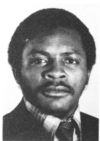 Andrew Page
Andrew Page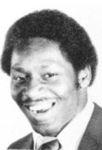 Reggie YoungAndrew Page and Reggie Young were the first evidence that Brooks was dead serious about recruiting. Page, a mobile QB from Santa Ana, spurned scholarship offers from Notre Dame, USC, Michigan, Colorado, Washington and Arizona to play for Oregon. Young was an all-American tailback out of Sacramento’s Rancho Cordova who could have gone anywhere he wanted and ultimately chose Oregon over Cal.
Reggie YoungAndrew Page and Reggie Young were the first evidence that Brooks was dead serious about recruiting. Page, a mobile QB from Santa Ana, spurned scholarship offers from Notre Dame, USC, Michigan, Colorado, Washington and Arizona to play for Oregon. Young was an all-American tailback out of Sacramento’s Rancho Cordova who could have gone anywhere he wanted and ultimately chose Oregon over Cal.
And they weren’t alone. Garrett Earle was an all-CIF lineman from UCLA’s back yard who picked Oregon over USC. Brooks snuck tailback Dwight Robertson out of Louisiana and away from LSU and Tulane. Linebacker Ed Hagerty, out of Chicago, went with the Ducks over Iowa. The Verbum Dei DB Kenny Lawler spurned UCLA for the Ducks. The top in-state prospect, Aloha’s speedy receiver Rourke Lowe, picked Oregon over Colorado, UCLA and Washington.
Of the 27 athletes signed, only four were from Oregon.
Young was so highly regarded that Brooks had joked before signing day that “if we get Reggie Young they’ll investigate us for sure. Nobody will figure out how we got him.” Cal coach Roger Theder, miffed at being scorned by his in-state prospect, told reporters Young probably wouldn’t have gotten into Cal anyway and would have had to go the juco route. During the Skywriters tour, WSU coach Jim Walden said “I’ve heard rumors that Reggie Young might not be eligible.” He offered no evidence and had not been asked about Young, but the situation prompted a headline in the Oregonian: “Reggie Young Is Eligible.”
I think Reggie could sue Jim Walden for slander. It sounds like sour grapes to me.”
– Rich Brooks
The truth was that Young had to take nine units in summer school at Oregon to qualify for admission. He made it.
The situation baffled Young.
Why would they recruit me if they thought I might have to go to junior college?”
— Reggie Young
Although Reggie Young was considered the biggest coup of the first full Brooks recruiting effort, it was Page who was recruited for his ability to run the team. Page reportedly was smart and athletic enough to run John Becker’s option schemes. In track he ran a 9.8 100 and put the shot 55 feet. The recruiting services liked him: “Very quick, good runner, legitimate 4.6 (40), real option threat, very inconsistent passer but a strong arm, could be a passer with coaching.” He was back of the year of his high school league and second-team All-Orange County. Brooks had recruited other QBs in the class, including Kevin Lusk out of Seattle Tyee and Wilson Pica from Concord (who was moved to DB), but Page was clearly his choice for the future.
The future needed to come soon. Oregon was paper thin at QB when practices opened in August of ‘78. Three-year starter Jack Henderson was gone. Backup Tim Durando, who had stepped in for a few games when Henderson was injured, was moved back to free safety. Mike Kennedy, a JC transfer from San Diego who had originally signed with Nebraska, had redshirted in ‘77 and never taken a snap in a D1 game before, but had thrown three picks in the spring alumni game. Dan Daly was recruited out of Spokane as a drop-back QB by Don Read, and wasn’t much of a runner. Page looked like a cinch to get significant playing time as a true freshman; Brooks wasn’t averse to the idea, and in fact had told several of the ‘78 recruits that they’d have a chance to play early and often.
Brooks had eschewed the philosophy of Don Read, who believed it was more important to get the in-state kids and then maybe you’d get lucky and grab one or two California kids that the big schools didn’t want.
Brooks was ebullient about his class. The Long Beach Independent Press-Telegram’s “Best in the West” list had three Oregon recruits listed – Young, Page and Lowe – and Washington had none.
“I bet you this is probably the best recruiting class the University of Oregon has seen in a long time, maybe ever … People around the league all of a sudden realize that we’re serious about recruiting.”
— Rich Brooks
And, after commenting in an interview about all the pressure that had been placed on Reggie Young during his recruiting process, Brooks said “Young ought to start the first game and do a hell of a job.” No pressure.
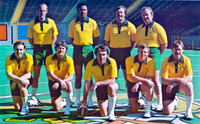 Oregon coaching staff, 1978. Front: Andy Christoff, Howard Tippett, Rich Brooks, John Becker, Joe Schaffeld. Back: Ron Hudson, Milt Jackson, Bill Tarrow, Bob McCray.A week into fall camp, it was clear the freshman class would be contributing early. And that was a problem. Brooks was worried about his team’s senior leadership, or more precisely the lack of same. Most of the seniors on the roster were JC transfers. There were only seven four-year seniors on the roster, of which just two – MLB Brian Beekley and WR Ken Page – had made significant contributions to the program. Admitting his team’s depth issues, Brooks told reporters
Oregon coaching staff, 1978. Front: Andy Christoff, Howard Tippett, Rich Brooks, John Becker, Joe Schaffeld. Back: Ron Hudson, Milt Jackson, Bill Tarrow, Bob McCray.A week into fall camp, it was clear the freshman class would be contributing early. And that was a problem. Brooks was worried about his team’s senior leadership, or more precisely the lack of same. Most of the seniors on the roster were JC transfers. There were only seven four-year seniors on the roster, of which just two – MLB Brian Beekley and WR Ken Page – had made significant contributions to the program. Admitting his team’s depth issues, Brooks told reporters
… we started eight freshmen at various times last year, and we might have that many again this year. That also lets you know that we’re not that strong a football team. But Oregon is no longer a patsy in recruiting. And following the same line I think it’ll be the same way on the field in two or three years.”
— Rich Brooks
It was unlikely to be the same way early in 1978. The freshmen and other underclassmen were making plenty of mistakes in practice. After one scrimmage, assistant John Becker was beside himself.
We were terrible.. we didn’t do anything right. We didn’t pass block well, we didn’t pass well, and we don’t have a guy clearly established at quarterback … We don’t have experience where we need it. And when the offensive line doesn’t perform like it should, it’s a total disaster.”
— Offensive coordinator John Becker
We’ll be a better football team than last year. I hope it’s reflected in the won-lost record; it may not be. But I have a feeling it will be.”
— Rich Brooks
Then, in the second week of fall camp, Andrew Page tore his ACL, and was declared out for the season. Two days later, sophomore DT Rick Price tore up his knee and joined Page on the sideline.
Coming off the 2-9 1977 campaign, Oregon was ranked #10 in Steve Harvey’s first “Bottom 10” poll.
***
Meanwhile, Colorado, coming off a 7-3-1 season under HC Bill Mallory, was expected to compete for the Big Eight championship. The Buffs were blessed with a schedule featuring eight home games – they wouldn’t leave Boulder until mid-October – and a number of puff pastries, including the Ducks. But Mallory was under pressure from boosters who thought they should be getting more for their investments.
After a late-season 1977 win over Kansas State, the team’s 13 seniors had issued a statement to the press chastising the boosters who had been hounding Mallory. It was a strong showing of solidarity for the coach; but the fact was that Mallory’s charges since 1974 had gone 9-3 with a bowl loss, then 8-4 with a bowl loss, then 7-3-1 with no bowl. With their first five games against teams with combined 1977 records of 13-41-1, it was inconceivable that Colorado wouldn’t make its first road trip carrying an unbeaten record. This would be considered “necessary, but not sufficient” for Mallory to keep his job.
There was nothing mysterious about Colorado’s approach to football. They would, in the words of a Denver sportswriter, “just line up and run it right at you. They will run the fullback 25 or 30 times a game, might call 20 passes … This is a big, veteran football team with no real weaknesses.”
***
In Eugene, Mike Kennedy was named starting QB for the opener in Boulder, in a decision that was essentially a coin flip. Becker said the position was “the biggest question mark on our football team” and said the battle between Kennedy and Dan Daly was “very, very close … I really can’t tell what’s gonna happen there. Every other position on our offense is more clearly defined.” Kennedy figured he was on a short leash; “Coach told me I’m not coming out after one mistake, but I imagine if I mess up much…”
For his part, Brooks was hedging a bit. “I’m more nervous than I was a year ago at this time … I know this team is better, and if we get good quarterbacking it will show up. If we don’t people might not think we’re any better at all.”
But he liked his freshman class.
These guys are cocksure; they don’t tend to be intimidated. Frankly, they’re a little wild. They act more like football players.
I think the last staff demanded flawless character from those they recruited. We’ve got good kids, but they’re independent and they might cause you a few problems.”
— Rich Brooks
(If he’d only known how right he would prove to be with that last statement…)
The only freshman on the starting lineup was Young, although starting CB Rock Richmond, a JC transfer from John Becker’s old school, Los Angeles Valley, was new to D1 football as well. But the two-deep had lots of new names – freshmen Pica, Lawler, Vobora, Hagerty, Mike Berkich, linemen Chris Cosgrove and Mike Honeycutt on defense; Lowe and Bisharat on offense. And against a powerful team like Colorado, the rookies figured to see a lot of playing time.
The smart money noticed. Oddsmakers established Colorado as 20-point favorites.
“They’re a better team than Georgia,” said Brooks, comparing Colorado to last season’s opening opponent. The Oregon staff was flying blind trying to prepare for the Buffs. Colorado was installing a new veer option for 1978; the Duck coaches had planned to scout the team during Colorado’s spring game, but the contest was snowed out. “I’d much rather know exactly what they’re going to do” with the veer option, said Brooks, “but we’ll just have to prepare for what we think they’ll do.
“I just hope we get a chance to see it, because if we do it means we’ve shut them down inside. Last year we didn’t shut anybody down inside who was any good.”
What Colorado figured to do was a lot of handing the ball to James Mayberry. The 5-11, 215 pound bowling ball of a fullback had racked up 1299 yards in 1977 and had seven 100+ yard efforts, including a 250-yard game against Oklahoma State that earned him an SI Player of the Week honor. He was #2 on Colorado’s all-time rushing season list and gained the most yardage ever by a Big Eight fullback. Mayberry ran behind one of college football’s biggest offensive lines, led by massive 275-lb tackle Matt Miller.
The predicted Boulder weather at game time: sunny, in the mid-80s. How would the young Ducks respond to the combined challenges of opponent and environment?
***
Well, they covered the spread. And played pretty well. Colorado didn’t have a sustained long drive in the game, a surprising outcome considering their style of play. Oregon had more first downs (17 to 15), a slight edge in time of possession and ran 89 plays to 77 for Colorado. The best fullback on the field was Vince Williams, who racked up 105 yards on 19 carries; Mayberry had 53 on 11. The defense flew around the field and held Colorado to 322 yards. Punter Mike Babb was great, averaging almost 50 yards a kick and repeatedly pinning Colorado deep.
So how does that translate to a 24-7 whipping?
Offensively, Oregon was killed by quarterback play that was at best inconsistent, along with an inability to block 260 pound defensive linemen with 240 pound offensive linemen. Defensively, Brooks learned what happens when you shut down a team inside. Colorado made a living running option plays outside the ends, racking up most of their 256 rushing yards left and right. They didn’t pass much, but several drives were sustained by key passes in difficult situations.
For a while, it was a game. The defense was early-season ragged but occasionally brilliant for both teams. Colorado’s Mark Haynes blocked a 40 yard Pat English field goal attempt in the first quarter, after Oregon’s opening drive was extended when Babb was roughed. Colorado’s first threat was snuffed by a Mike Nolan interception at the two-yard line, but the Buffs were eventually able to grind their way downfield on runs by Mayberry and halfback Mike Koslowski; a one-yard stumble by QB Pat Cyphers, and Oregon trailed 7-0. It seemed that might be the worst-case halftime margin, but with around two minutes remaining Brooks gambled on 4th and five on the Colorado 42, and lost, Kennedy having overthrown WR Paul Bachtold. Colorado took advantage of the field position and Pete Dadiotis nailed a 40 yard FG with one second left in the half for what proved to be the winning points.
Daly started the 3rd quarter, moving his team after the kickoff to Colorado’s 42, but a screen pass to tailback Ed Radcliff was picked off by CU linebacker Bill Roe, and the field position change eventually led to a Mayberry TD and a seventeen point deficit. (Brooks: “It wasn’t thrown very well, but Radcliff ran the wrong way.”) Down three scores, Brooks put Kennedy back in the game, but another screen pass – this one intended for Dwight Robertson – went awry, and CU tackle George Visger picked it off, returning it to the Duck 14. Three plays later, Colorado’s backup QB Bill Solomon ran it in for Colorado’s final score.
But there would be no shutout. Kennedy settled down, hitting Curt Jackson for 13 and Jon Brosterhous for 20 on sideline routes against Colorado’s reserves; and even after Mallory waved his starters back onto the field, Kennedy tallied his first touchdown pass as a Duck with a quick 11 yard look-in to Ken Page with under two minutes left.
Reggie Young only managed 26 yards on 12 carries, and was swarmed almost every time he carried the ball. “Colorado was quicker than we thought,” Brooks said after the game. “There was no place for Reggie to run.
Offensively, we hurt ourselves, but they were correctable mistakes … I was pleased that we scored late and played strongly in the fourth quarter. That showed something. It was great that we took it in against Colorado’s first unit, too.”
— Rich Brooks
DE Terry Dion: “When we were fresh, we played well. I think we showed some personality. We never rolled over, even when we were tired.” After giving up over 400 yards to six different teams in 1977, the defense showed signs of progress.
***
This was Vince Williams’ breakout game. His 105 yard effort was only the second time an Oregon back had gone over the century mark since 1975. He would break 100 three more times in 1978, and become the poster boy for the 1979 ad campaign. And Dwight Robertson tore up OSU in the Civil War, scoring three touchdowns.
But the fears of Rich Brooks for the 1978 season – that the improvement might not be reflected in the won-loss record – came horribly true.
Oregon lost the first seven games of 1978, beating only WSU and OSU to finish 2-9 again. But six of those losses were by six points or less. The defense never stopped flying around the field. The QB play was never great; Tim Durando was converted back from safety, replacing Daly, who transferred to WSU in frustration after just two games. But a number of the other freshmen gained valuable experience. And in 1979 Brooks would finally get the dynamic QB he’d wanted all along, a JC transfer from Miami named Reggie Ogburn.
Reggie Young and Andrew Page never lived up to the hype they arrived with. For the season, Young only managed 161 yards on 59 carries, with two TDs. Miffed at a lack of playing time, he transferred to Hawaii along with Page.
Page, whose once-promising career as an Oregon quarterback amounted to four plays in garbage time in 1979, is notorious for being the only player convicted on criminal charges arising from investigations into the “sports scandal” of the late 1970s that landed Oregon on probation in 1980. He plead guilty to first-degree sexual abuse, and was sentenced to seven months in jail.
Several of the other freshmen did make significant contributions during their four- or five-season careers at Oregon, notably placekicker Pat English; LBs Chris Cosgrove, Ed Hagerty and Andy Vobora; walk-on WR Greg Moser; QB Kevin Lusk and RB Dwight Robertson. But overall, the class will be remembered for its notoriety. Page, Young, and Robertson spent years battling charges of sexual abuse after an incident in the University Inn. Rock Richmond left the team after being declared ineligible in the phony credits scandal, which led to forfeited wins from the 1979 season.
Colorado did win every game in that season-opening homestand, by an average score of 27-7, and rose as high as #13 in the AP poll. But the Buffs went 1-5 the rest of the way, and a 20-16 home loss to Iowa State left them in 7th place in the Big Eight. This sealed the fate of head coach Bill Mallory, who was sacked with two years remaining on his $34,500 annual contract. Chuck Fairbanks was lured away from coaching the New England Patriots to Boulder, in a move that touched off lawsuits; in a deposition, Fairbanks admitted he had spent three weeks working on the Colorado program while preparing the Pats for the NFL playoffs.
Mallory eventually spent time as head coach at Northern Illinois and Indiana, but his legacy to Colorado football is in large part his contribution to the massive NCAA penalties imposed on the football program in 1980.
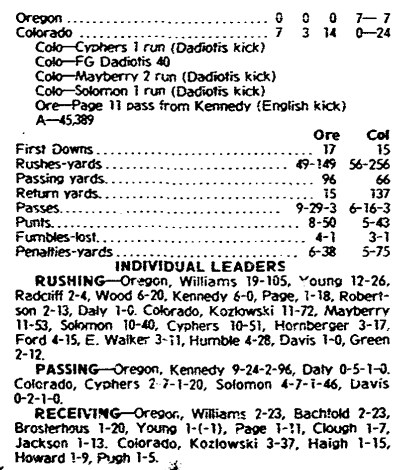
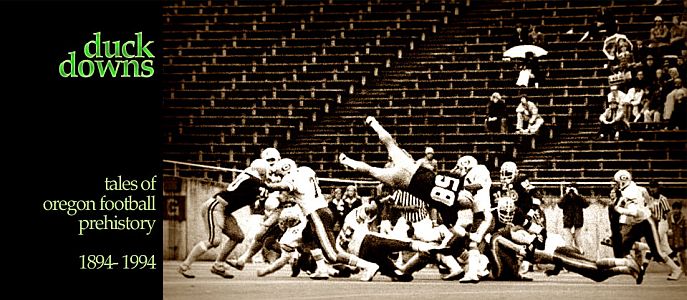
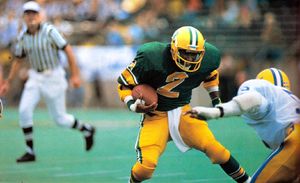
 benzduck
benzduck
Reader Comments